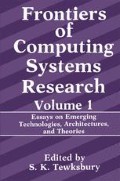Abstract
We formally coarse-grain the microscopic equations of motion which determine the dynamical behavior of a class of cellular automata by projection-operator methods. Thus, we obtain a macroscopic description in terms of Langevin equations for the slow long-lifetime thermodynamic variables, such as order parameters. The dynamical rules for the automata are modeled by equations which are similar to Hamilton’s equations. For reversible automata, we obtain the standard results of nonequilibrium statistical physics, namely, fluctuation-dissipation relations, Onsager’s symmetry relations, and Green-Kubo relations. For dynamical rules which have both reversible and irreversible parts we find that none of these results apply. For irreversible rules, we obtain an exact result: the slow variable is linearly unstable due to a “fluctuation-enhancement” relation. This can imply that the structure in the irreversible cellular automata grows exponentially for early times. We also discuss the relationship of our results to the growth of ordered structure in physical systems.
Access this chapter
Tax calculation will be finalised at checkout
Purchases are for personal use only
Preview
Unable to display preview. Download preview PDF.
References
J. von Neumann, in Theory of Self-Reproducing Automata, edited by A. W. Birks (Univ. of Illinois Press, Urbana, IL, 1966).
Theory and Applications of Cellular Automata edited by S. Wolfram (World Science, Singapore, 1986)
T. Toffolli and N. Margolus, Cellular Automata Machines (MIT press, Cambridge MA, 1987)
S. Wolfram, Rev. Mod. Phys. 55, 601 (1983).
Physica (Amsterdam) 10D, 1–247 (1984).
E. Domany and W. Kinzel, Phys. Rev. Lett. 53, 311 (1984)
C. H. Bennett and G. Grinstein, Phys. Rev. Lett. 55, 657 (1985).
G. Grinstein, C. Jayaprakesh, and Y. He, Phys. Rev. Lett. 55, 2527 (1985).
S. Chandrasekhar, Rev. Mod. Phys. 15, 1 (1943).
S. Chandrasekhar, Rev. Mod. Phys. 21, 383 (1949).
A. Einstein, Ann. Phys. (Leipzig) 17, 549 (1905).
P. Langevin, C. R. Acad. Sci. (Paris) 146, 530 (1908).
L. Onsager, Phys. Rev. 37, 405 (1931).
L. Onsager, Phys. Rev. 38, 2265 (1931).
M. S. Green, J. Chem. Phys. 20, 1281 (1952).
R. Kubo, J. Phys. Soc. Jpn. 12, 570 (1957).
R. Kubo, M. Yokota, and S. Nakajima, J. Phys. Soc. Jpn. 12, 1203 (1957)
R. Kubo, Rep. Prog. Phys. 29, 255 (1966).
R. Zwanzig, J. Chem. Phys. 33, 1338 (1960).
R. Zwanzig, on Lectures in Theoretical Physics, edited by W. E. Brittin, B. W. Downs, and J. Downs (Interscience, New York, 1961), Vol. 3.
H. Mori, Prog. Theor. Phys. 33, 423 (1965).
H. Mori, Prog. Theor. Phys. 34, 399 (1965).
R. Zwanzig, Phys. Rev. 124, 983 (1961).
H. Mori, Prog. Theor. Phys. 49, 764 (1973).
H. Mori, Prog. Theor. Phys. 49, 1516 (1973).
K. Kawasaki, Ann. Phys. (N. Y.) 61, 1 (1970).
D. Forster, Hydrodynamic Fluctuations, Broken Symmetry, and Correlation Functions (Benjamin, Reading, MA, 1975).
J. P. Boon and S. Yip, Molecular Hydrodynamics (McGraw-Hill, New York, 1980).
N. G. van Kampen, Stochastic Methods in Physics and Chemistry (North-Holland, Amsterdam, 1981).
P. Resibois, in Proceedings of the Sixth IUPAP Conference on Statistical Mechanics, edited by S. Rice (Univ. of Chicago Press, Chicago, IL, 1972).
M. Grant and J. D. Gunton, Phys. Rev. Lett. 57, 1970 (1986).
J. A. McLennan, Adv. Chem. Phys. 5, 260 (1963).
K. Kawasaki, J. Phys. A 6, 1289 (1973), has used projection-operator techniques to study nonequilibrium steady states..
J. W. Cahn, Trans. Mettal. Soc. AIME 242, 166 (1968).
J. E. Hilliard, in Phase Transformations, edited by H. I. Aronson (American Society of Metals, Ohio, 1970).
H. E. Cook, Acta Metall. 18, 297 (1970)
J. D. Gunton, M. San Miguel, and P. S. Sahni, in Phase Transitions and Critical Phenomena, edited by C. Domb and J. L. Lebowitz (Academic, London, 1983), Vol. 8.
W. W. Mullins and R. F. Sekerka, J. Appl. Phys. 34, 323 (1963).
W. W. Mullins and R. F. Sekerka, J. Appl. Phys. 35, 444 (1964).
J. S. Langer, Rev. Mod. Phys. 52, 1 (1980).
M. Laradji, M. Sc. thesis (McGill University, 1989).
M. Laradji, M. Grant, M. J. Zuckermann, and W. Klein, McGill University preprint.
I. Prigogine, in Order and Fluctuations in Equilibrium and Nonequilibrium Statistical Physics, edited by G. Nicolis, G. Dewer, and J. W. Turner (Wiley, New York, 1981), p. 35.
H. Haken, Synergetics (Springer-Verlag, New York, 1983).
P. Glansdorff and I. Prigogine, Thermodynamic Theory of Structure, Stability and Fluctuations (Wiley, New York, 1971).
G. Nicolis and I. Prigogine, Self-Organization in Nonequilibrium Systems (Wiley, New York, 1977).
J. L. Lebowitz, Physica 140A, 232 (1986).
Author information
Authors and Affiliations
Editor information
Editors and Affiliations
Rights and permissions
Copyright information
© 1990 Plenum Press, New York
About this chapter
Cite this chapter
Grant, M., Gunton, J.D. (1990). Stability of Continuous Cellular Automata. In: Tewksbury, S.K. (eds) Frontiers of Computing Systems Research. Frontiers of Computing Systems Research, vol 1. Springer, Boston, MA. https://doi.org/10.1007/978-1-4613-0633-7_2
Download citation
DOI: https://doi.org/10.1007/978-1-4613-0633-7_2
Publisher Name: Springer, Boston, MA
Print ISBN: 978-1-4612-7902-0
Online ISBN: 978-1-4613-0633-7
eBook Packages: Springer Book Archive

